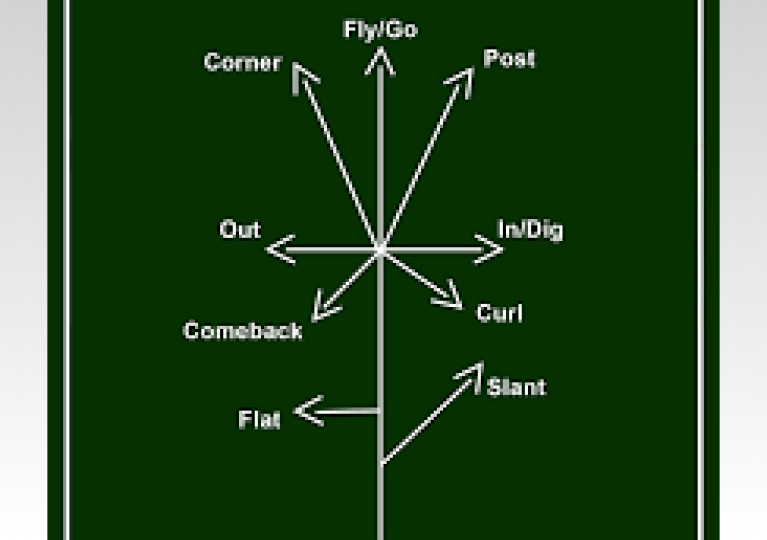Football Routes are different paths that a receiver takes in order to get open for a forward pass. You can understand it as a path to the next stop for the ball. It is imperative for you to know all the Football Routes if you want to become an expert player. Football Routes form the basis for every move in the football match. Routes in a football match are run by the wide receivers, running backs, and tight ends. This does not mean that only their players need to be aware of the routes. Every player in the team should be aware of the football routes because players from other football positions can also act as the receivers depending upon the play.
No matter what the play is, it is usually the receiver who is asked to run a specific route in order to attack the number of levels of defense that the other team has established, and keep the defenders off balance. This is a big responsibility for the receivers, and so they need to have the football routes clear in their heads.
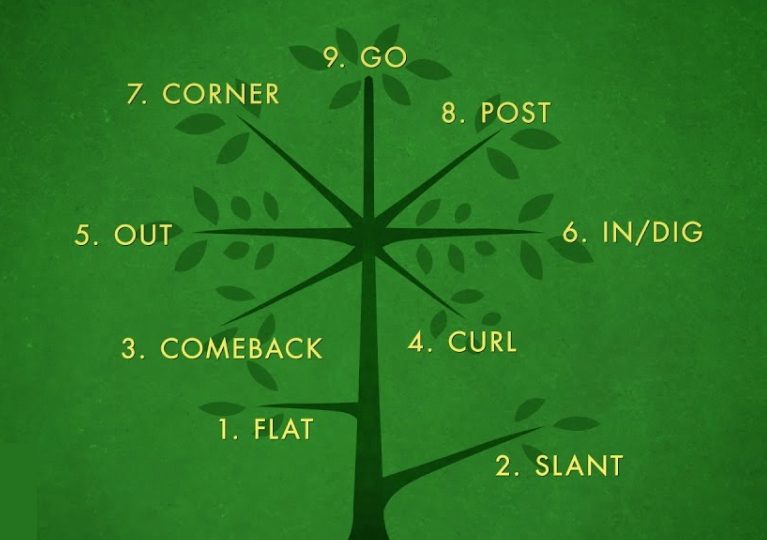
In total there are 9 Football Routes. In order to make it easier for the players to remember all the Football Routes, these 9 routes are organized in a diagram resembling a tree. This is often referred to as the ‘route tree’. Thus, the route tree is a pictorial representation to show all the 9 routes in a comprehensive manner.
Knowing how the football routes are run in a match and the best possible route in any given situation is very important for every player. Therefore we have included here all the information you can need to understand each and every Football Route.
- Flat Football Route
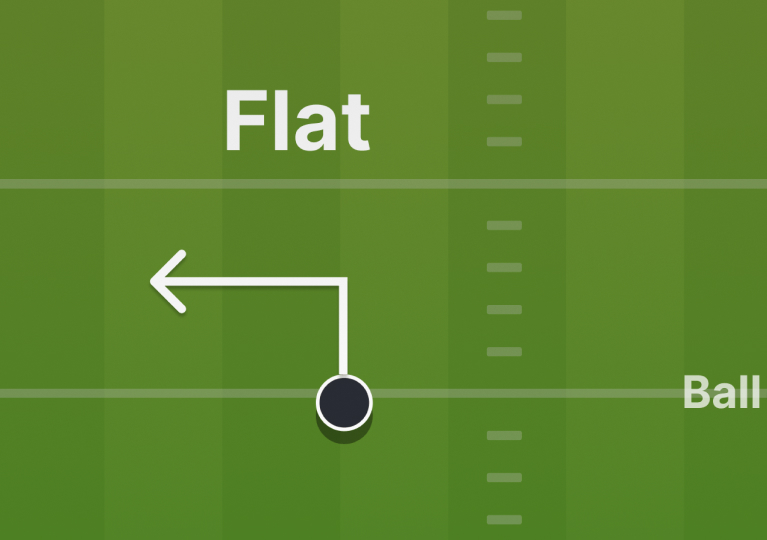
The flat route is the most basic route to run. While running this route the receiver quickly breaks to the outside of the field towards the sidelines. For this, the receiver simply runs forwards for a few paces and then cuts to their right or left towards whichever sideline is the closest to them. The route is usually used along with long posts, long corners, or fly routes in a football match. It is run by the wide receivers who are lined up in one of the three spots: the slot, the tight ends, or the running backs.
This is how this route runs in a match:
The receiver running the play will run parallel to the line scrimmage then turn towards the nearest sideline. They will then turn towards the quarterback to pass the ball to them.
The outside wide receivers do not run this route because there is a huge space between the sideline and the position they line up on the field.
- The Slant Football Route:
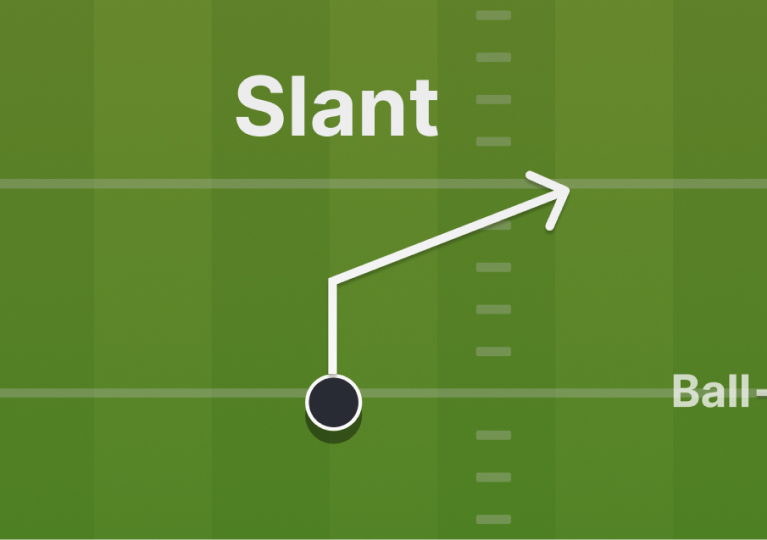
The slant is a route similar to the flat, both of these Football Routes are quick-hitting football routes. While running a slant, the receiver takes a few quick steps forward and then takes an inside break diagonally, this explains the name of the route, the slant. The receiver is literally slanting diagonally across the field.
The purpose of this play is to separate the receiver and the defenders and to place the receiver between the defender and the quarterback.
Most of the time in a match this football pass route is used when the corner or Nickelback are playing a distance from the receiver. This enables the team to carry out a quick pass before the defender can try to break up the pass.
The most amazing thing about this route is that it can be run by a player in any football position, from any alignment, and at any depth. And slants can be short, medium, or deep, depending upon where the receiver is and where they need to get to.
Since slants are quick-hitting Football Routes, the quarterback is required to get the ball out of their hands as quickly as possible, to someone running a slant.
- The Comeback Football Route:

The comeback route is another out-breaking route. The name of the route very well describes the running of this route. It is a comeback route because the receiver literally moves back after running a few paces ahead.
In this route, the receiver takes a quick run straight ahead down the field, he would then abruptly stop and slant back towards the sideline and the line of scrimmage.
This route showcases the very popular “back-shoulder throw” route, where the quarterback gets the opportunity to show off their arm strength on the route. The quarterback throws the ball to a part of the receiver’s body that only the receiver can get to.
The outside wide receiver usually runs the comeback Football Routes. This is because this route uses the sideline as well as the ability of the receiver to shield the defenders, for which they use both their body as well as the sideline.
- The Curl Football Route:
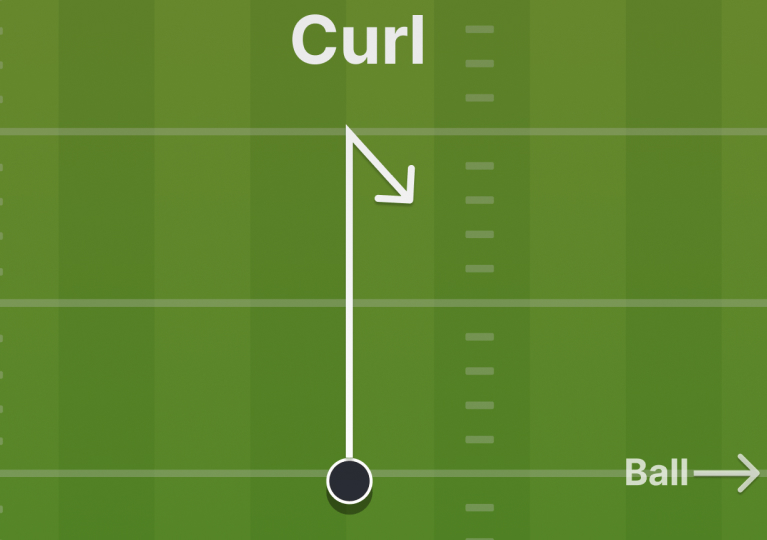
The route tree in football is made up of counterpart routes to each route. The curl route is the counterpart of the comeback. If you look at the route tree you can clearly see how they are both the same kind of route but in the opposite directions.
When running this route, the receiver breaks backward to the inside of the field. The comeback and the curl can be option routes from each other. What this means is that depending on the receiver, either of the two can be used. The only important thing is that the quarterback and receiver have to be on the same page.
The curl route is one of those Football Routes where quick and accurate passes are favored.
Another name for this move is the screen. This is because, in the pursuit of this move, one or more linemen, tight ends, or running backs run towards the receiver creating a screen. This is done so that the linemen can block the initial pursuing defender. This ensures that the receiver has enough time and space to run along the field once they have caught the ball.
- The Out Football Route
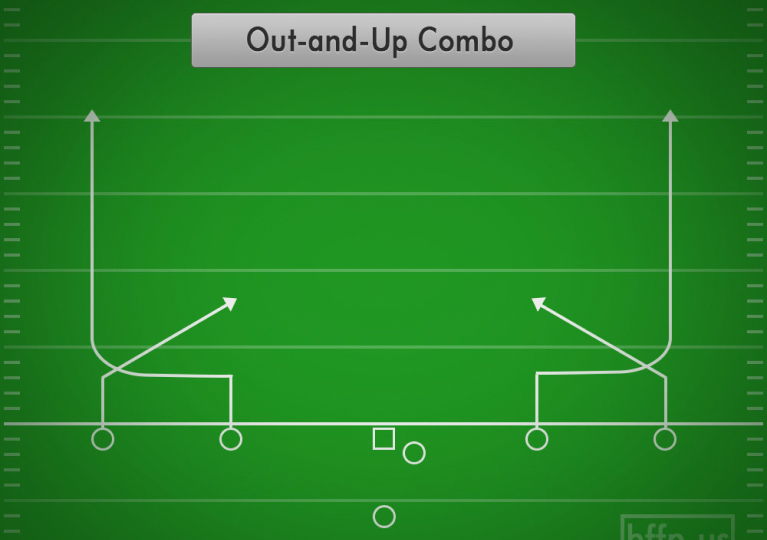
The out route is a route similar to the flat, the only difference between the two routes is that the out route is done much deeper into the field. The receiver and quarterback both need to work proficiently to run this route successfully. Since the receiver will be much further down the field, the quarterback will have to display their arm strength. The ball has to be in the air for quite some time before it reaches the receiver, thus the throw needs to be a strong one with a lot of momentum.
The out is run somewhere between 10 to 15 yards downfield, unlike the flat which is run at a depth of only a few yards from the line of scrimmage. The Football Route is run by the receivers. This route like other football routes also requires taking advantage of the sideline and hence the receivers are the ones pursuing it.
While making the cut for the out route, if the receiver makes the cut too quickly, only a few steps after running forward, it is called the ‘quick out’ route. An advantage that our routes offer is that they allow for the one-on-one matchup between the receiver and the defensive back guarding the receiver. This is crucial because the safeties are usually more concerned with longer routers downfield or at the center of the field.
- In or out Dig Football Route:
The in or out route has several names. It goes by the names of in route, dig route as well as drag route. In the route tree, it is the counterpart of the out route.
For this, the receiver runs up to 10-15 yards downfield in a straight line, and the sharpy cuts directly across the field at a 90-degree angle towards the inside of the field. Running this route requires a lot of precision on the part of the receiver.
While this route, the receiver is supposed to deceive the opponent defender. The receiver is supposed to run in a manner to project that they are going deep in the field running the deep route. It is only at the last minute that the receiver takes an abrupt horizontal turn to create a separation from the defender without the help of sideline benefit.
The dig route is one of the most difficult Football Routes to cover in man-to-man coverage. This route can also be a dangerous route to run. The reason for this is that if the pass is intercepted by the defender, they will end up getting a clear path to the end zone.
For the receiver, too, this passing route can be a little tedious because it puts the receiver in a dangerous position where they are liable to get hurt. The receiver is in the way of the extra defenders as the receiver has to run across the middle of the field.
- The Corner Football Route:
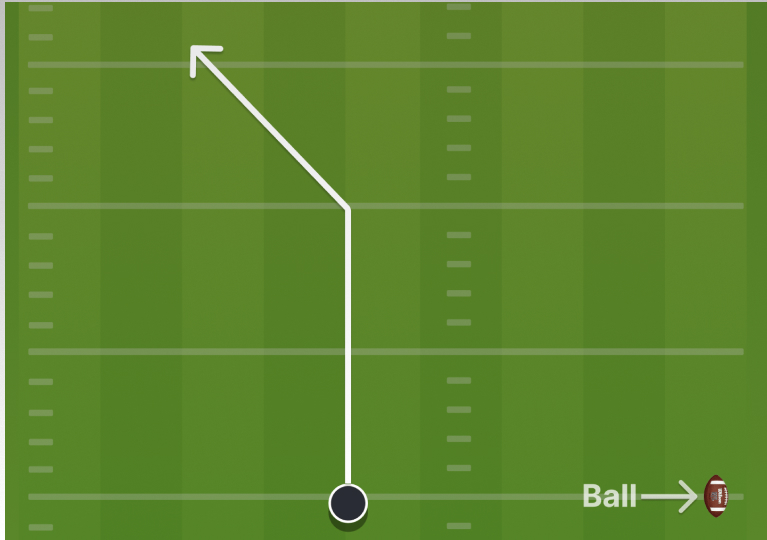
The routes from the corner onwards are the deeper routes in the football route tree, and the corner route is one of those routes used in football. This is run at 10 to 15 yards downfield. The receiver sprints straight to the 10 to 15-yard depth of the field and thereon they will run diagonally towards the deep outside of the field. Using the corner route, the receivers attack the deep outside corner of the field to their advantage.
Both the corner route as well as the slant route finish in the diagonal direction. However, the purpose of the corner route is a little different. Unlike in the slant route where the receiver makes a sharp cut, thus limiting the depth of the route, in the corner route the receiver is supposed to slant at such an angle that it allows the receiver to get some depth.
It is when the defensive back is playing towards the inside shoulder of the receiver, that the corner passing route is used. This creates a one on one vertical matchup. When comparing the slant and the corner, it is better as it is not very likely to be intercepted. This advantage is afforded to corner passing routes as the ball is thrown away from the middle of the field in the case of the latter.
- The Post Football Route:
The post route forms the counterpart for the corner route on the football route tree. It is also run in the same manner as the corner route. The only difference between the two routes is the direction in which the receiver turns. While in the corner route the receiver runs towards the outside of the field, in the case of the post route, the receiver runs towards the inside of the field.
This route allows for the creation of space between the defender and the receiver, while at the same time attacking an open space deep down the middle.
To effectively carry out this route, the receiver needs to have the ability to proficiently catch the ball even while they are standing in a surrounded position. The receiver also needs to have the vertical ability and the strength to rise above the safety and get hold of the ball.
A variant of the post-football Route is called a skinny post route. In the football route, the receiver is supposed to cut infield at a shallower angle. This route is strategically designed to find a fault in the deep coverage. Using this route, the receiver can cut shallow inside the sideline defender, while at the same time not drawing out the middle defenders.
- Fly Football Route:
The fly route is known by many names like the straight route, vertical route, streak route or go route. In the route, the receiver will run straight ahead to the end zone. The receiver simply runs at top speed downfield, as deep as they can go. The purpose of this route is the separate the receiver from the defenders who might have anticipated that the receiver will break away into another route from the football route tree.
For this passing route, the receiver has to be really quick so much so that the speed of the receiver forces the defender to break out they’re backpedal motion, turn their back to the line of scrimmage and run alongside the receiver.
This affords a great advantage to the receiver because they know when the ball is thrown. And advantage that the defender would be devoid of. The quarterback needs to have a very strong throwing arm since they have to throw the ball over 30 yards in the air before it is caught by the receiver.
There are also a few combination routes that are used in football apart from the routes mentioned in the football tree.
The idea of creating a route tree in football is not just to make it visually appealing. Instead, it cements the idea that when a player has knowledge of all routes, they already are at a vantage point. The offensive plays that can incorporate multiple passing routes from the football route tree are the best football plays.

